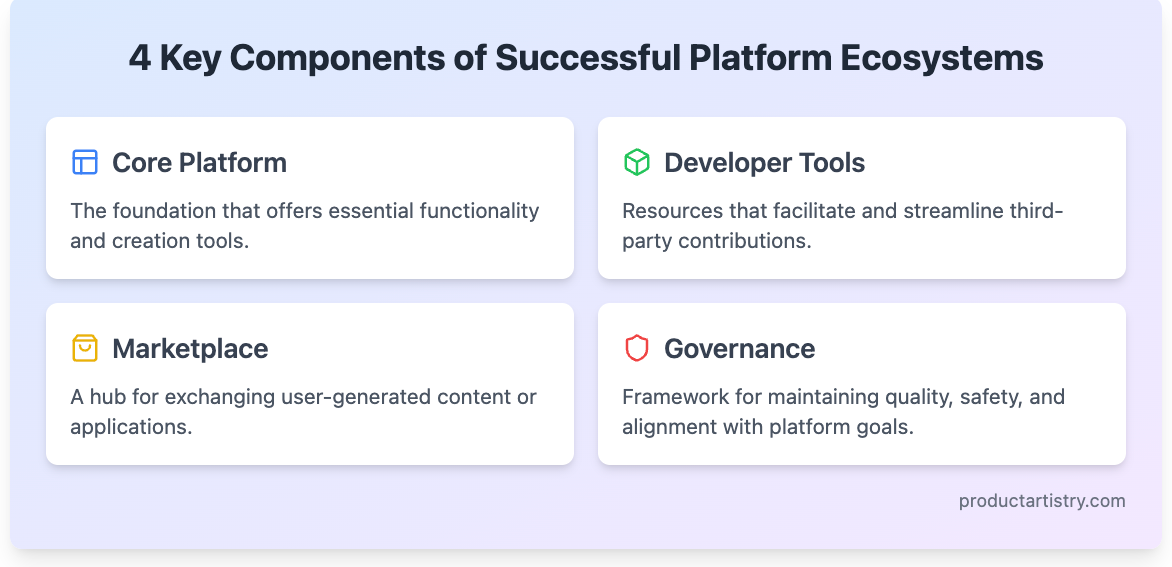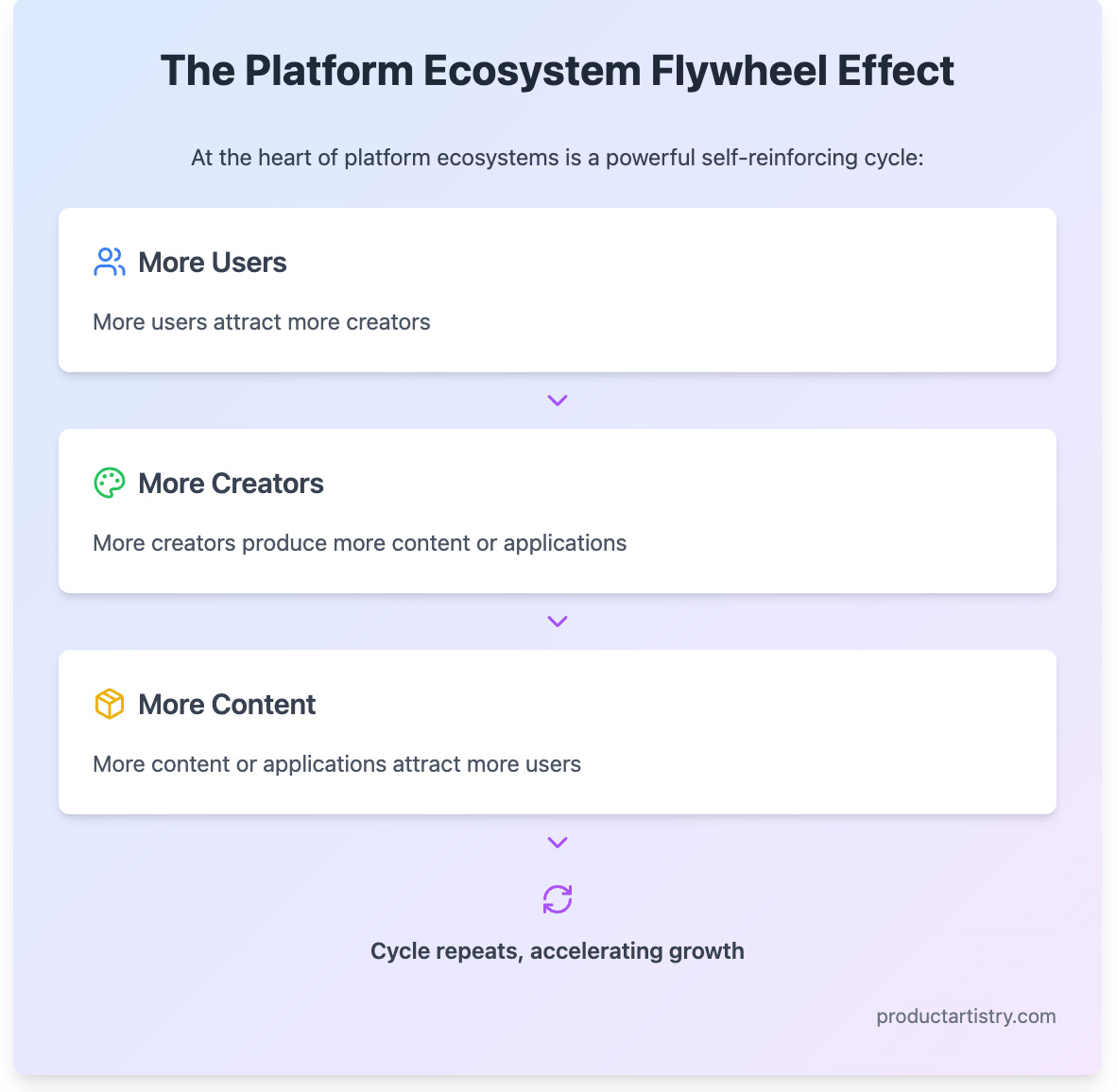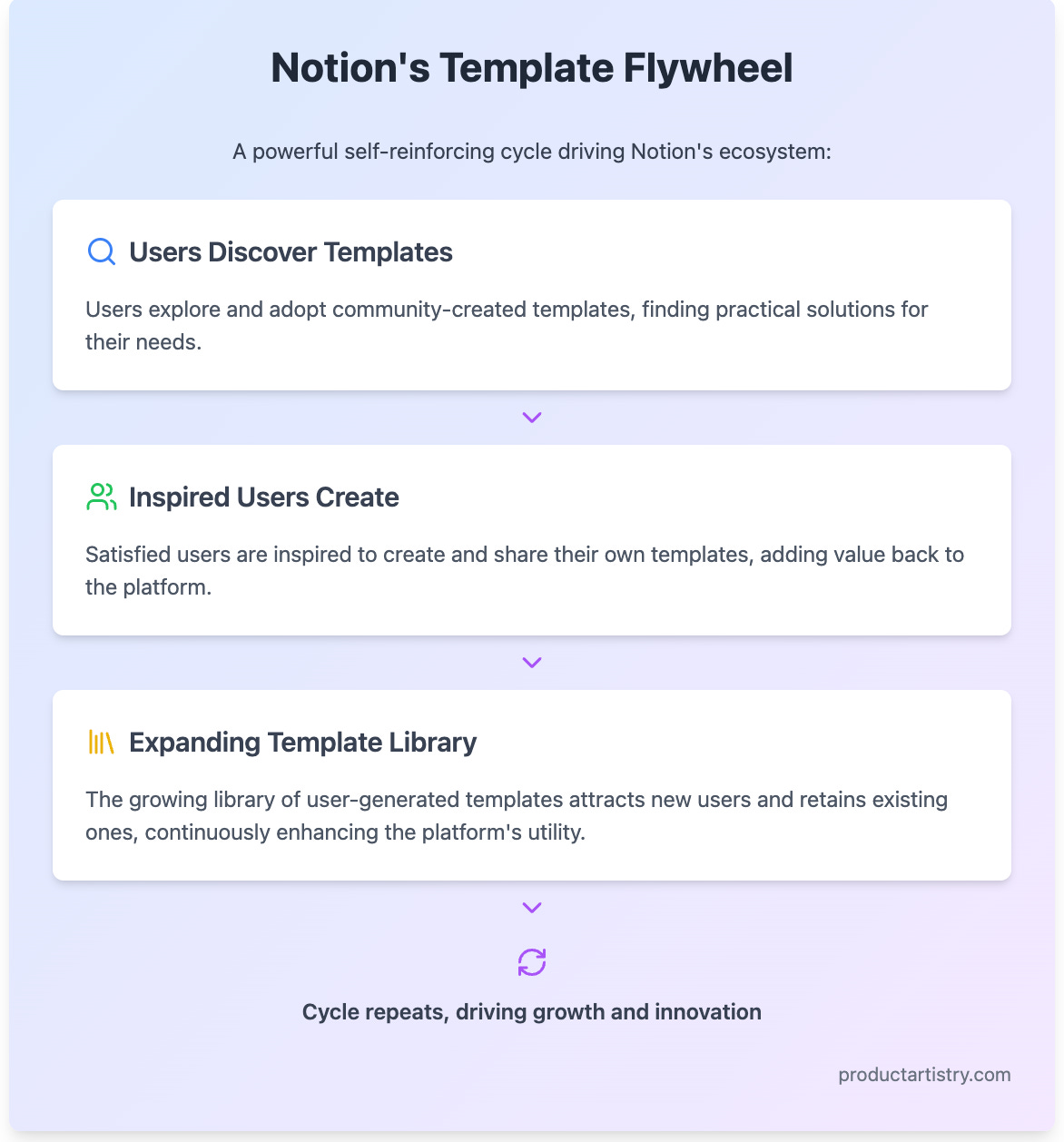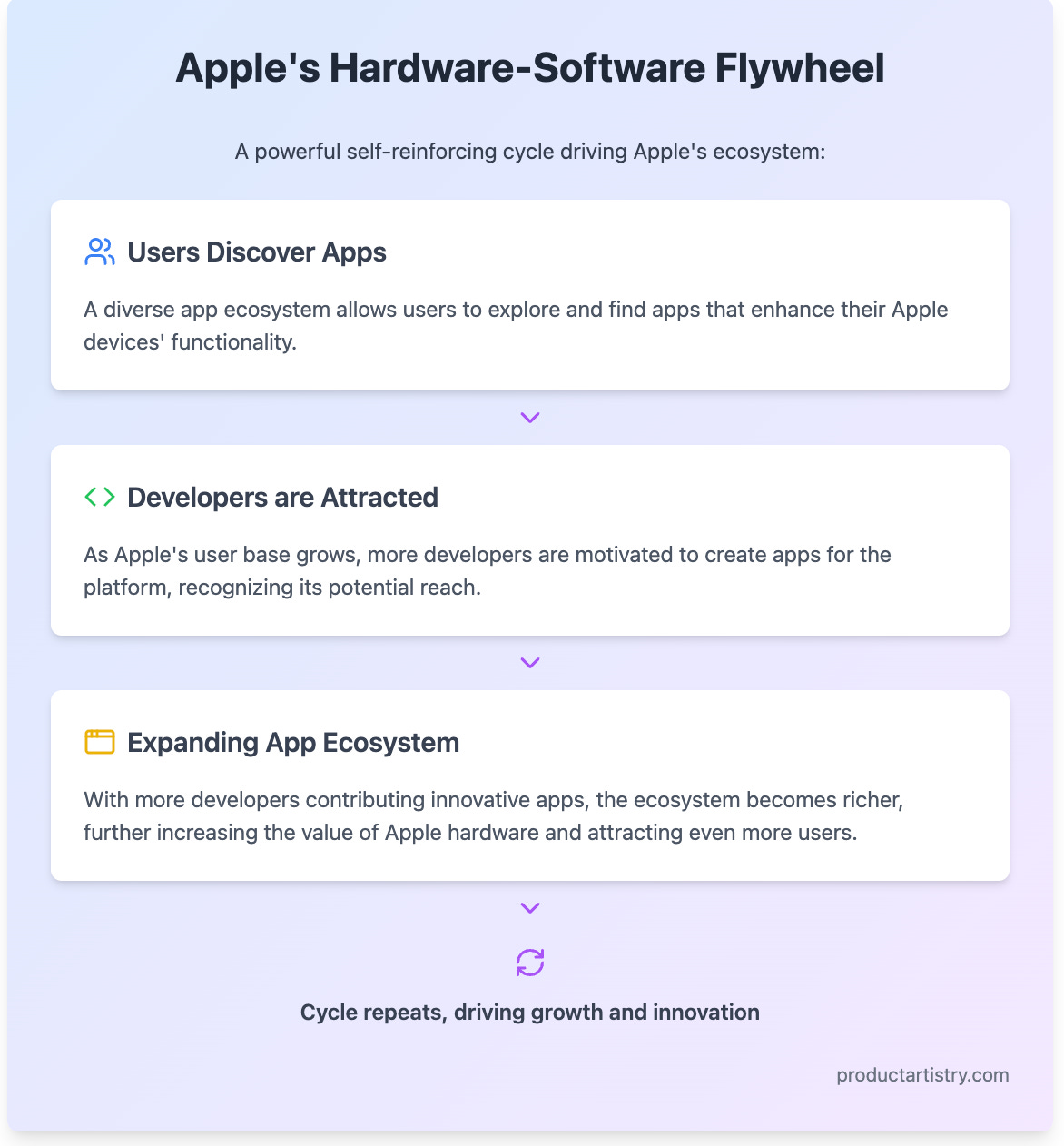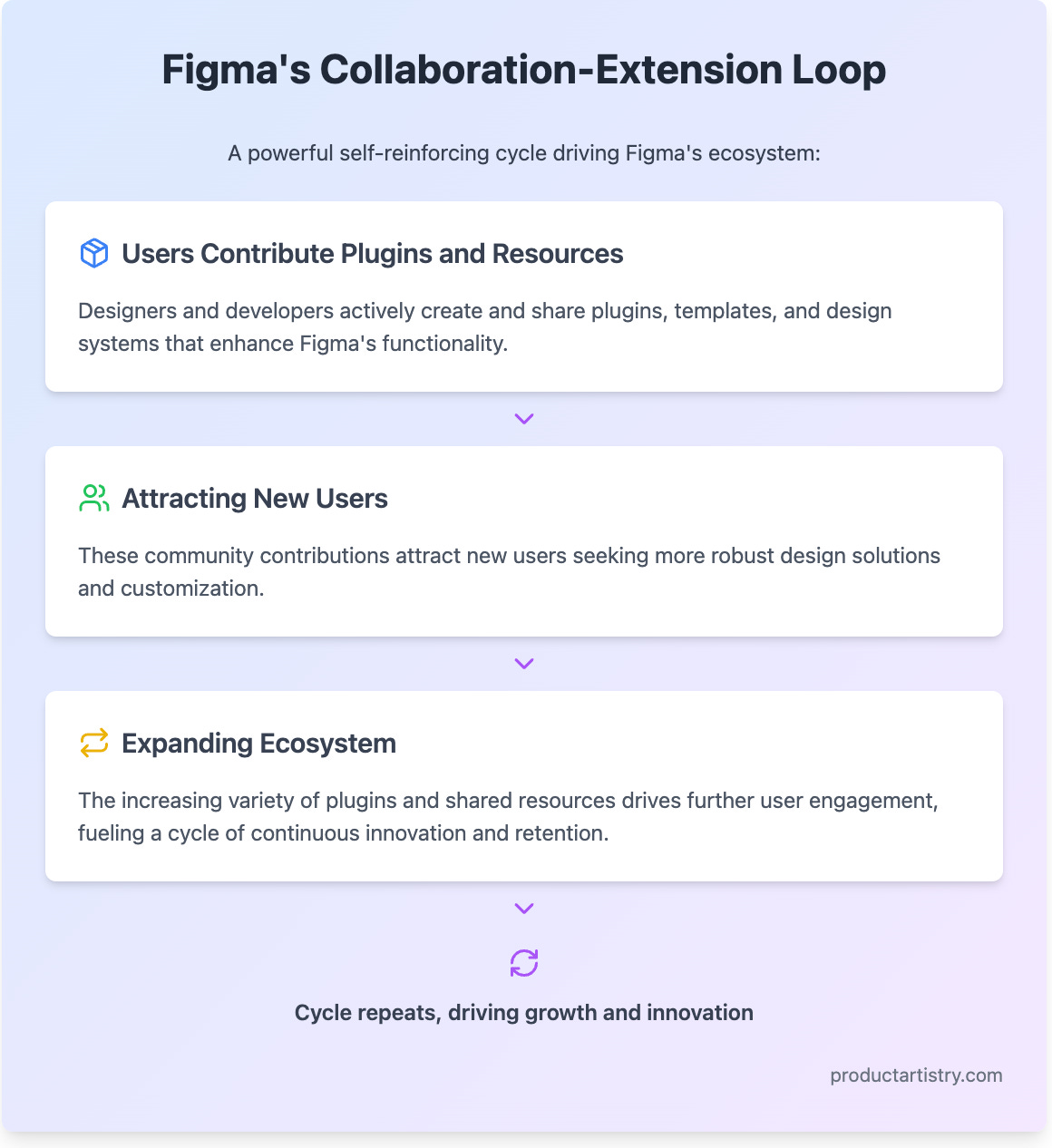How Platform Ecosystems Drive Product Growth: A Deep Dive
The New Frontier of Product Strategy: Unlocking Innovation and Scalability Through Platform Ecosystems
Behind some of today’s most successful companies is a powerful growth engine: platform ecosystems. Unlike traditional product models, platforms enable users and developers to actively build, innovate, and contribute, driving exponential growth.
In this article, we’ll explore the strategies behind these thriving ecosystems and show you how to leverage their principles to transform your product into a self-sustaining, innovation-driven platform.
By the end of this article, you'll gain:
A grasp of platform ecosystem fundamentals: Understanding of how User Contribution, Symbiotic Community, and Compounding Value drive growth.
Insights from 3 case studies: Lessons from Notion, Apple, and Figma's success in transforming users into creators.
Knowledge of platform dynamics: Ability to harness flywheel effects, network effects, and aligned incentives for scalability.
Ecosystem implementation strategies: Methods to apply platform principles for boosting innovation, engagement, and growth in your product.
Skills to navigate ecosystem challenges: Techniques to address governance, curation, and quality control for building a sustainable platform.
1. Introduction: The Rise of Platform Ecosystems
Platform ecosystems are revolutionizing product development and growth strategies. By harnessing the collective creativity of users and developers, companies are unleashing innovation at unprecedented scales.
Consider Apple's App Store, a marketplace that now generates over $1 trillion in developer billings per year. Or Notion, where user-created templates have evolved a simple note-taking app into a versatile productivity platform for almost any use-case. These examples highlight a fundamental shift in how modern products evolve and scale.
What is a Platform Ecosystem?
At its core, a platform ecosystem is a product or service that empowers external parties — whether users, developers, or partners — to create and exchange value.
Platform ecosystems revolve around three core principles:
Creator Contribution: The platform enables both users and developers to create, not just consume.
Symbiotic Community: A collaborative environment where creators and consumers coexist and add value to each other.
Compounding Value: Each contribution enriches the platform, creating exponential growth over time.
Anatomy of Successful Platform Ecosystems
To understand how these ecosystems thrive, it’s essential to break them down into four key components:
Core Platform: The foundation that offers essential functionality and creation tools.
Developer Tools: Resources that facilitate and streamline third-party contributions, making it easy for creators to build on the platform.
Marketplace: A hub for exchanging user-generated content or applications.
Governance: A framework for maintaining quality, safety, and alignment with the platform’s goals.
These components work together to cultivate an ecosystem where innovation flourishes, engagement deepens, and growth accelerates. Companies that master these elements create thriving communities of contributors who continuously enhance the platform’s value.
💡 Section 1 Takeaways: Platform ecosystems are catalysts for innovation, engagement, and long-term growth. As you consider building or optimizing your product ecosystem, ask yourself:
How can we empower our users and developers to contribute meaningfully to our platform’s growth?
Are we cultivating a symbiotic community that encourages both creation and consumption?
How can we structure contributions to generate compounding value over time?
By focusing on these questions, you can create a platform that thrives on external contributions, deepens user engagement, and builds exponential growth over time.
2. Understanding Platform Ecosystems: Benefits and Mechanics
Now that we’ve established what platform ecosystems are, let’s explore why they’re so powerful and how they function. These systems operate on a self-reinforcing flywheel effect — a virtuous cycle of growth and innovation that traditional product models simply cannot match.
The Platform Ecosystem Flywheel Effect
At the heart of every successful platform ecosystem is the flywheel effect:
This cycle works as follows:
More Users: An expanding user base attracts more creators.
More Creators: These creators build more content or applications.
More Content: The new content, in turn, attracts more users.
As the cycle repeats, it accelerates growth and innovation, generating increasing momentum that becomes difficult for competitors to disrupt. This powerful dynamic allows platform ecosystems to scale far beyond the limitations of traditional product models.
Key Benefits of Platform Ecosystems
Exponential Growth: Unlike traditional products, which tend to experience linear growth, platform ecosystems grow exponentially. Every new user or piece of content adds value to the system, attracting even more participants and fueling rapid expansion.
Innovation at Scale: Platform ecosystems thrive on distributed innovation, with a global network of creators contributing fresh ideas and solutions. This decentralized approach enables faster experimentation and adaptation, fostering innovation on a scale that no single company could achieve internally.
Enhanced User Value: As the ecosystem grows, users benefit from a wider array of options, functionalities, and features — often at no additional cost to the platform. This creates a compounding value effect that enhances the user experience over time.
Robust Network Effects: The more users and creators participate, the greater the value of the ecosystem. These network effects create a sticky environment, making it challenging for users to switch to competing products and driving long-term user retention.
Mechanics of Success
To ensure the flywheel effect and network effects take root, successful platform ecosystems focus on several critical mechanics:
Low Barrier to Entry: Making it easy for users and creators to join the ecosystem is essential. This often involves intuitive interfaces, clear documentation, and strong community support to help users and developers get started quickly.
Aligned Incentives: For a platform ecosystem to thrive, incentives must be aligned between the platform, its users, and creators. Fair revenue-sharing models, recognition programs, and other forms of motivation ensure sustained participation and high-quality contributions.
Curation and Discovery: As content and applications proliferate, effective curation mechanisms become crucial for users to find valuable content. This also enables standout creators to gain visibility, increasing the overall quality of the ecosystem.
Governance and Quality Control: Successful platforms strike a balance between openness and control. Governance structures help maintain high standards while ensuring creativity isn't stifled. This balance protects the integrity of the platform while maintaining an innovative, collaborative environment.
💡 Section 2 Takeaways: Platform ecosystems thrive through self-reinforcing dynamics that drive both innovation and exponential growth. To harness this potential, consider these key questions:
How can we design a flywheel effect that encourages user participation and creator engagement?
Are we lowering barriers to entry for users and developers to contribute to our platform?
How aligned are the incentives for all stakeholders (platform, users, and creators) to ensure sustained contributions?
By focusing on reducing friction, aligning incentives, and nurturing the flywheel effect, you can unlock powerful network effects that lead to scalable innovation and long-term retention.
3. Case Studies in Platform Ecosystem Success
Let’s look at three companies that have successfully leveraged their ecosystems for remarkable growth, Notion, Apple, and Figma:
Notion’s Template Gallery: Crowdsourcing Innovation and Driving Feature Adoption
Notion transformed its product by empowering users to create and share templates, turning them into active contributors and significantly expanding the platform’s utility.
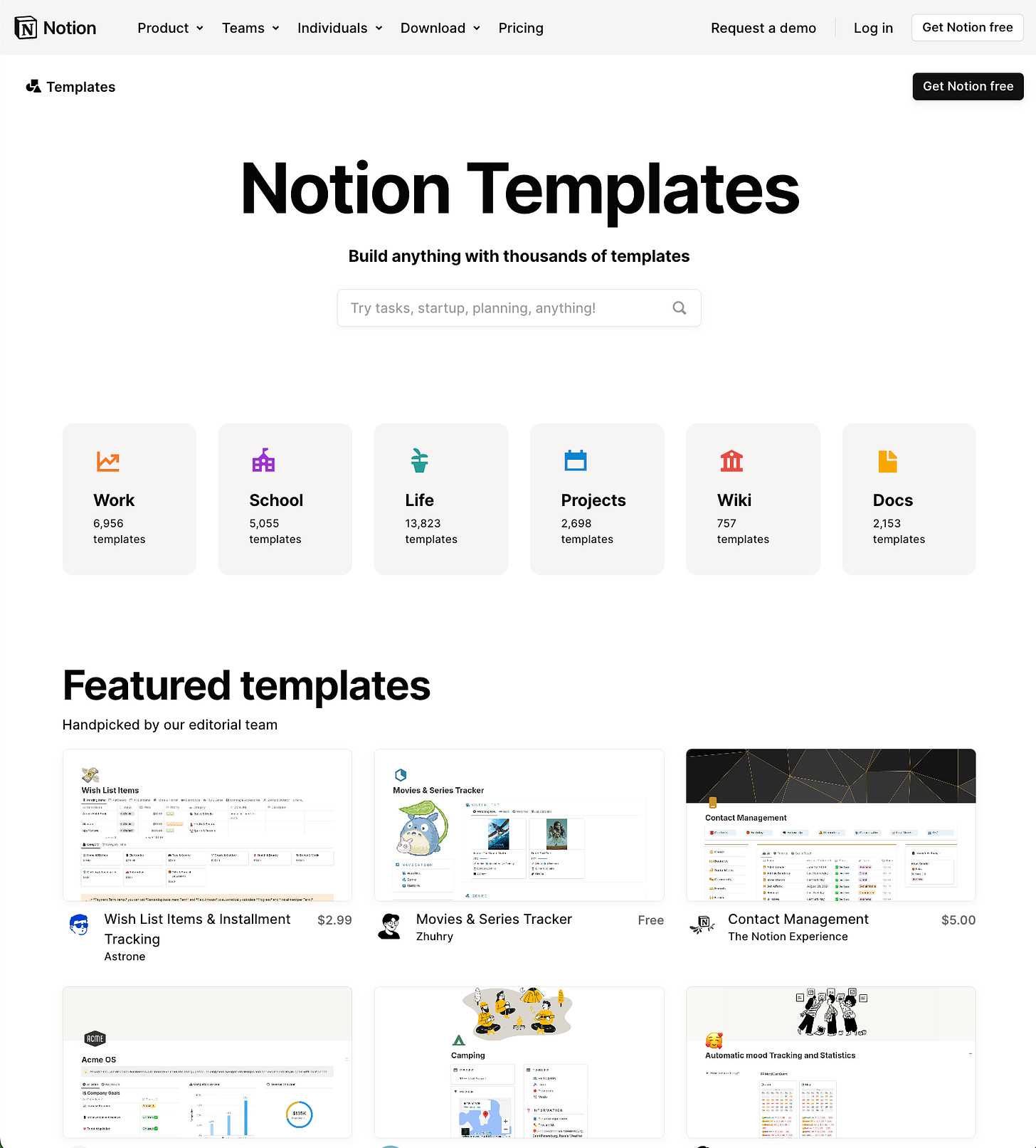
The Strategic Shift: From In-House Creation to Community-Driven Innovation
Traditional Approach: Notion initially created templates internally for different use cases.
New Strategy: By opening template creation to the community, Notion tapped into the collective creativity of its users, reducing internal resource strain and driving innovation at scale.
Key Elements of Success:
Strategic Outsourcing: The community-generated templates provide diverse, real-world-tested solutions, enhancing Notion’s value.
Early Access for Creators: Giving template creators early access to new features allowed Notion to rapidly iterate and adopt new functionality.
Enhanced Feature Adoption: The ready-made templates help users adopt new features faster by showing practical applications.
Notion’s Template Flywheel:
Users Discover Templates: Users explore and adopt community-created templates, finding practical solutions for their needs.
Inspired Users Create: Satisfied users are inspired to create and share their own templates, adding value back to the platform.
Expanding Template Library: The growing library of user-generated templates attracts new users and retains existing ones, continuously enhancing the platform’s utility.
The Lesson: By empowering its users as creators, Notion has successfully driven feature adoption and nurtured sustained engagement, creating a self-reinforcing cycle of innovation.
🎁 Secret Bonus: Thanks for sticking with me through this deep dive! As a token of appreciation, I wanted to share a Free Guided Product Requirements Document (PRD) Template I’ve created for Notion — I hope you may find it helpful. You can find it in the official Notion Template Gallery here.
Apple’s App Store Model: Harnessing Developer Creativity to Enhance Hardware Value
Apple revolutionized the mobile software market by opening its iOS platform to third-party developers, building a vast app ecosystem that enhances the value of its hardware.

The Strategic Shift: From Closed System to Developer-Driven Ecosystem
Traditional Approach: Apple used to rely primarily on in-house development for software functionalities.
New Strategy: By allowing third-party developers to create apps, Apple rapidly expanded the use cases for its hardware, driving both software innovation and hardware sales.
Key Elements of Success:
Outsourced Innovation: Apple tapped into the global developer community, allowing the platform to scale in ways that Apple’s internal team alone could never achieve.
Quality Control and Curation: The strict app review guidelines and submission process ensures high standards, while editorial highlights and awards spotlight top-tier developers.
Platform-Exclusive Features: Developers are encouraged to build apps that leverage unique iOS/iPadOS/WatchOS/VisionOS features, making these apps — and by extension Apple’s hardware — more valuable.
Apple’s Hardware-Software Flywheel:
Users Discover Apps: A diverse app ecosystem allows users to explore and find apps that enhance their Apple devices’ functionality.
Developers are Attracted: As Apple’s user base grows, more developers are motivated to create apps for the platform, recognizing its potential reach.
Expanding App Ecosystem: With more developers contributing innovative apps, the ecosystem becomes richer, further increasing the value of Apple hardware and attracting even more users.
The Lesson: By outsourcing innovation to developers while maintaining strict quality control, Apple has created a self-reinforcing ecosystem that strengthens both its hardware and software offerings. This strategy has resulted in strong platform lock-in as users become deeply invested in the unique experiences available on iOS.
Figma: Collaborative Design Platform Ecosystem
Figma disrupted the design tool industry by creating a platform where designers, developers, and teams collaborate in real time, fostering an ecosystem of creativity and extensibility.

The Strategic Shift: From Standalone Tool to Collaborative Ecosystem
Traditional Approach: Most design tools prior to Figma were standalone software with limited collaboration features.
New Strategy: Figma introduced a cloud-based platform that not only offers real-time collaboration but also empowers users to extend its functionality through plugins and shared design systems, creating a highly integrated and flexible design environment.
Key Elements of Success:
Cloud-Based Collaboration: Figma’s real-time design tool allows multiple users to collaborate on projects from anywhere, enhancing teamwork across design, development, and other teams.
Community Contributions: Figma’s active community creates and shares plugins, templates, and design resources, enriching the platform and driving value for all users.
Extensibility: The plugin architecture allows developers to extend Figma’s core functionality, meeting diverse needs across industries and workflows.
Figma’s Collaboration-Extension Loop:
Users Contribute Plugins and Resources: Designers and developers actively create and share plugins, templates, and design systems that enhance Figma’s functionality.
Attracting New Users: These community contributions attract new users seeking more robust design solutions and customization.
Expanding Ecosystem: The increasing variety of plugins and shared resources drives further user engagement, fueling a cycle of continuous innovation and retention.
The Lesson: Figma’s success shows how creating a collaborative and extensible platform ecosystem can drive user engagement, community contributions, and cross-functional collaboration, fueling growth in highly competitive markets.
💡 Section 3 Takeaways: Successful platform ecosystems like Notion, Apple, and Figma provide valuable lessons in enabling community-driven innovation. To emulate their success, ask yourself:
How can we enable users and developers to become active creators and not just consumers?
Are we providing the tools and infrastructure needed for external innovation to flourish?
How do we maintain quality control while still encouraging openness and creativity within the ecosystem?
By enabling creators, balancing governance, and curating high-value contributions, you can build a robust platform ecosystem that attracts and retains engaged users while scaling innovation.
4. Key Insights from Successful Platform Ecosystems
From our exploration of the Notion, Apple, Figma platform ecosystems, several crucial insights emerge. These guiding principles can help product managers and business leaders develop and nurture their own platform ecosystems effectively:
Start with a Strong Core Value Proposition
A successful platform ecosystem begins with a core product that solves a real problem or fulfills a genuine need.
Notion: Its core note-taking and organizational features were foundational to its ecosystem's success.
Apple: The iPhone provided a revolutionary base for developers to build innovative apps.
Figma: Its real-time, cloud-based design tool was critical in creating a collaborative design environment.
Key Insight: Ensure your core product provides standalone value before expanding into a platform. Without this, users and contributors may not see the benefit of joining or contributing to your ecosystem.
Empower Creators with Robust Tools
Creators thrive when they have access to powerful, user-friendly tools that allow them to innovate and contribute.
Notion: Its flexible database structure empowers users to create and share templates that meet specific needs.
Apple: Comprehensive SDKs lower the barrier to entry for developers, making app creation accessible.
Figma: The plugin architecture allows developers to extend functionality and share these tools with the wider community.
Key Insight: Invest in intuitive and powerful tools that align with your platform’s strengths, enabling contributors to easily create and add value.
Align Incentives for All Stakeholders
For an ecosystem to thrive, there must be mutual benefits for all participants.
Apple: The revenue-sharing model incentivizes developers by providing clear financial rewards for high-quality apps.
Notion: Its template gallery gives creators visibility and recognition within the community, showcasing their work to a broad audience.
Figma: Plugin creators gain recognition and influence within the design community, driving adoption and contributing to their professional reputation.
Key Insight: Design your ecosystem to reward contributors—whether financially or through recognition — while benefiting both your business and end-users.
Balance Openness with Quality Control
Openness fosters innovation, but quality control is essential to maintain user trust and platform stability.Apple: A strict app review process ensures apps meet high standards for security and functionality, protecting the user experience.
Notion: Its community guidelines maintain professionalism and usability within the template gallery, ensuring quality.
Figma: The platform encourages openness with plugins but sets clear expectations for functionality and user experience, ensuring reliability.
Key Insight: Implement clear guidelines and review processes to maintain quality while encouraging creativity and openness.
Foster Community and Collaboration
A thriving ecosystem needs a strong community where creators can share, collaborate, and learn from each other.
Notion: Active user forums and community groups enable collaboration and shared learning, creating long-term engagement.
Apple: Developer conferences like WWDC bring developers together to collaborate, learn, and gain insights into Apple’s evolving ecosystem.
Figma: Its community space for design resources and templates encourages collaboration between designers and developers, driving innovation.
Key Insight: Invest in community-building initiatives to create a space where creators can collaborate, share knowledge, and drive innovation.
Continuously Evolve and Adapt
Successful ecosystems consistently introduce new features and capabilities to keep users and contributors engaged.
Notion: Regular updates expand flexibility, encouraging users to create more templates and workflows.
Apple: Annual OS updates provide developers with new tools and features to innovate and expand app capabilities.
Figma: The platform frequently introduces new tools and core products like FigJam, which expands its use cases and attracts new contributors.
Key Insight: Continuously introduce new features and capabilities to keep your platform dynamic and provide fresh opportunities for innovation.
Leverage Data for Ecosystem Insights
Platforms that leverage data analytics can better understand user needs and optimize the ecosystem for growth.
Notion: Tracks template usage and activity to identify trends and optimize future features and updates.
Apple: Analyzes app performance and developer success to inform App Store algorithms and surface the best apps for users.
Figma: Uses data on plugin usage and design resource popularity to identify trends and guide the platform's development.
Key Insight: Use robust analytics to gain insights into your ecosystem’s health and make informed strategic decisions that benefit both contributors and users.
💡 Section 4 Takeaways: Platform ecosystems rely on a balance of innovation, user value, and continuous evolution. For your ecosystem to thrive, reflect on these key questions:
Does our core product offer enough standalone value to attract users before expanding into an ecosystem?
Are we continuously evolving the platform with new features and capabilities to keep contributors engaged?
How are we leveraging data to better understand user contributions and optimize growth?
Building a successful platform ecosystem requires you to maintain strong product fundamentals, while empowering contributors and adapting to the changing needs of your community.
5. Conclusion: The Future of Platform-Driven Product Development
The principles of platform ecosystems are set to become increasingly essential across industries as user expectations evolve and the pace of innovation accelerates. Tapping into a global network of creators and innovators will provide a significant competitive edge for businesses that embrace this approach.
For product managers and business leaders, the question is no longer whether to adopt a platform model, but how to implement it effectively. As you contemplate your product's future, ask yourself:
How can your users actively contribute to and expand your product’s value?
What untapped potential for innovation exists within your user base?
How can you foster creativity while aligning with your strategic goals?
Building a platform ecosystem is not without its challenges, but the potential for transformative growth makes it a path worth pursuing. The most successful platforms create value for all participants — the company, the creators, and the end-users — ensuring long-term success and engagement.
By embracing the principles of platform ecosystems, you cultivate an environment where innovation thrives, and your product evolves in ways previously unimaginable.
The future of product development is collaborative, dynamic, and community-driven.
Thanks for reading!—Found value in this? Three ways to help:
Like, Comment, and Share—Help increase the reach of these ideas
Subscribe for free—Join our community of makers
Become a paid subscriber—Support this creative journey
Keep Iterating,
—Rohan




